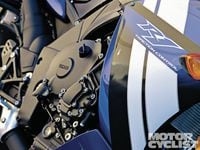It's likely that every literbike will someday be appointed with traction control, but we figured Yamaha's YZF-R1 would be the last to get it. That's because the R1 already has outstanding traction characteristics, its Crossplane crankshaft and ride-by-wire throttle letting the rider manage rear-wheel slides easier than on any other sportbike without TC.
But with computer-controlled throttle butterflies already in place, adding electronic spin suppression was just a software download away. Aside from a tome ring on the front wheel and a rocker switch on the left handlebar, outfitting the 2012 R1 with TC didn't require any additional hardware.
Yamaha's Traction Control System (TCS) employs pre-existing rpm, throttle- and gear-position data feeds, plus front-wheel speed input to monitor and maintain rear-wheel traction. The math involved in interpreting the data is complex, but the result is beautifully simple: seamless and totally transparent slide management. The system offers seven levels of intervention (one to six bars on the LCD, plus off), and is adjusted via the aforementioned switch. Changing modes can be done on the fly but requires pulling in the clutch lever. To turn the system off entirely, the bike must be stopped. Yamaha says the TCS is self-calibrating, and can accommodate all common tire sizes and adjust to minor gearing changes.
TCS is certainly big news, but the R1 received a few other changes as well. A minor facelift finds the headlights squinting more aggressively, with larger LED marker lights in the corners of the air intakes and reflectors extending down the edges of the openings. Out back, the muffler heat shield and end caps have been redesigned to help reduce the perceived size of the Yamaha's posterior. Other changes include a lighter-rate shock spring and a new top triple clamp that's cast to look more like the machined piece on Ben Spies' YZR-M1 MotoGP machine. This past season marked Yamaha's 50th anniversary in GP racing, and to celebrate the YZF-R1 is available in a limited-edition white/red livery.
Moto-journalists had the chance to experience the 2012 R1 for two days in Southern California: half a day exploring the mountain roads above Palm Springs followed by a full day at Chuckwalla Valley Raceway in nearby Desert Center. Riding up State Route 74 reminded me just how tractable the Crossplane engine is. It also reacquainted me with the R1's heavy steering, stiff brakes and searing engine heat. If you ride in hot weather, it will test your pain threshold!
My TC-testing obligations (and an addictive exhaust note) prompted full-throttle inputs at every opportunity. I never got the rear Dunlop Qualifier II to spin on the street, but I did get the anti-wheelie feature in Level 5 and 6 to kick in. Unlike other systems that let the front end drop abruptly, Yamaha's TCS gently returns the tire to terra firma.
Levering on sticky, aggressive-profile Michelin Power One race tires for the track greatly improved the R1's sluggish steering, but quick transitions still required a lot of muscle. On the track, TCS Level 5 and 6 proved too sensitive, hindering drive off corners and causing the amber light on the dash to flicker constantly.
Moving to the lower, less intrusive levels revealed a surprisingly smooth response to slides. The first line of defense in spin control is the R1's Yamaha Chip Controlled Throttle (YCC-T). When the ECU senses a slide, it closes the throttle plates slightly, just like a skilled rider would. When active, the R1 exhibits no popping or sputtering; if you covered the TCS lamp on the dash, you'd never know it was working. The R1 has always excelled at rocketing out of corners, and I eagerly employed the TCS to see just how much gas I could apply off the apex. In every instance I was able to roll on earlier and faster than caution would normally allow. In Level 1 with the gentler "B" drive mode selected, I was able to roll the throttle wide-open with my knee on the deck without the TCS light illuminating. Even in full-power "A" mode, it took some ham-fisted antics to get the light to blink. Mad props to the grippy Michelins, but credit is also due to that incredible "long-bang" motor, whose uneven power pulses give the rear contact patch a better chance of staying stuck.
Yamaha's YZF-R1 has always been the least likely superbike to slide, and the easiest to ride with the rear tire spinning. Did the R1 need traction control? Not really, but TCS certainly makes it easier and safer to exploit the bike's awesome power. And when the 2012 updates only add $400 to the bottom line, it's hard to argue with Yamaha's decision. Perhaps TC will become commonplace faster than we thought...
tech Spec
EVOLUTION
Our 2009 pick for Motorcycle of the Year receives minor cosmetic changes and a seriously effective TC system.
RIVALS
Aprilia RSV4R APRC, BMW S1000RR, Ducati 1199 Panigale, MV Agusta F4RR, Kawasaki ZX-10R.
TECH
Easier to go fast on than ever before, and not much more expensive. Aside from the engine heat, what's not to like?














/cloudfront-us-east-1.images.arcpublishing.com/octane/QCZEPHQAMRHZPLHTDJBIJVWL3M.jpg)
/cloudfront-us-east-1.images.arcpublishing.com/octane/HXOUJXQWA5HBHGRO3EMJIGFMVI.jpg)

/cloudfront-us-east-1.images.arcpublishing.com/octane/3TIWWRV4JBBOLDVGRYECVVTA7Y.jpg)
/cloudfront-us-east-1.images.arcpublishing.com/octane/KIX5O23D5NAIBGFXBN3327DKZU.jpg)
/cloudfront-us-east-1.images.arcpublishing.com/octane/7GJYDUIPXRGMTMQKN6ONYOLBOU.jpg)
/cloudfront-us-east-1.images.arcpublishing.com/octane/MUQLOVLL2ZDGFH25ILABNBXKTI.jpg)
/cloudfront-us-east-1.images.arcpublishing.com/octane/TNOU5DNE2BC57MFPMGN2EIDXAM.jpg)
/cloudfront-us-east-1.images.arcpublishing.com/octane/GTCXACQGJ5HAPDTGWUQKDEH44E.jpg)
/cloudfront-us-east-1.images.arcpublishing.com/octane/S35YGSEMEZB4BLTDJTSZPF4GLA.jpg)
/cloudfront-us-east-1.images.arcpublishing.com/octane/5UOT6HPX2JFMRJAX6EH45AR4MQ.jpg)
/cloudfront-us-east-1.images.arcpublishing.com/octane/OKWOJWAKP5EP3OACCRRWPCIX2Q.jpg)
/cloudfront-us-east-1.images.arcpublishing.com/octane/2WF3SCE3NFBQXLDNJM7KMXA45E.jpg)
/cloudfront-us-east-1.images.arcpublishing.com/octane/G4MG6OUCJNBSHIS2MVVOTPX65E.jpg)
/cloudfront-us-east-1.images.arcpublishing.com/octane/IIGGWFOTOJGB7DB6DGBXCCMTDY.jpg)
/cloudfront-us-east-1.images.arcpublishing.com/octane/QSTCM6AVEZA5JJBUXNIQ3DSOF4.jpg)
/cloudfront-us-east-1.images.arcpublishing.com/octane/U4I7G625B5DMLF2DVIJDFZVV6M.jpg)
/cloudfront-us-east-1.images.arcpublishing.com/octane/B6XD6LS6IVCQPIU6HXDJSM3FHY.jpg)
/cloudfront-us-east-1.images.arcpublishing.com/octane/ICL63FEDDRDTTMINYICCEYGMDA.jpg)
/cloudfront-us-east-1.images.arcpublishing.com/octane/FCGZHQXRBZFLBAPC5SDIQLVF4I.jpg)
/cloudfront-us-east-1.images.arcpublishing.com/octane/WNOB6LDOIFFHJKPSVIWDYUGOPM.jpg)

/cloudfront-us-east-1.images.arcpublishing.com/octane/X33NU3E525ECRHXLNUJN2FTRKI.jpg)
/cloudfront-us-east-1.images.arcpublishing.com/octane/6KKT5NNL2JAVBOXMZYS5ZO76YA.jpg)